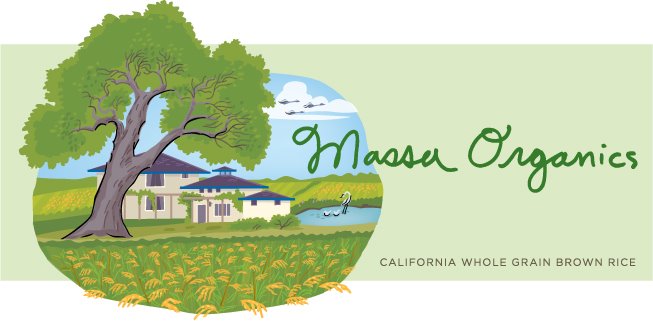Friday, December 28, 2007
Boulettes recipe for Dec 22
Massa Organics brown rice
herbs
apple cider vinegar
black currants
new olive oil
flax seeds
Friday, December 21, 2007
Harvest video
Rice harvest is completely mechanized in the United States, and uses very large, very expensive machinery. Much of the rest of the world still harvests by hand or with small equipment. You can see some of this if you search YouTube. In our case, we use a John Deere 9760 STS with a "stripper header." When you watch the video, the header is the blue and white thing on the front of the combine. Stripper headers are a relatively new technology, which greatly improves the efficiency of harvest by stripping the grain off the plant and leaving the plant stem standing in the field. By contrast, the older style headers cut off the entire plant and feed it into the combine, which then separates grain from straw. This takes much more time and fuel.
Here's the video of the combine with a stripper header:
Here is a video of the combine dumping rice into a truck.
Here is a view from the driver's seat. It's not great quality, but you get the idea.
Saturday, December 15, 2007
Boulettes Larder recipe for Dec. 15
saturday's ingredients-
walnuts
black currants
extra virgin olive oil
sherry vinegar
herbs (rosemary, parsley, some people said lavender - it might have been a homemade herbs de provence, but we're not sure)
Friday, December 14, 2007
Chard Dolmas
Swiss Chard Dolmas
1 bunch Swiss chard
3 cups cooked Massa Organics brown rice, at room temperature
1/4 cup olive oil
1/4 cup red wine vinegar
1 tablespoon dried dill
Salt and pepper
Combine rice, olive oil, vinegar and dill in a large mixing bowl and season with salt and pepper. Wash and trim the stems from the Swiss chard. Bring a large kettle of water to a boil and blanch the largest whole Swiss chard leaves for about 1 minute, until just tender. Remove the leaves from the water with tongs and transfer to a large cutting board. When the chard leaves have cooled, place the leaves face down one at a time on the board and use a sharp knifeto remove the thick central spine from the leaves, about two-thirds of the way up, leaving the fan of the leaves intact. Overlap the lower halves of each leaf to form a half-inch seam.
Place two heaping tablespoons of the rice mixture in the center of each Swiss chard leaf, leaving the edges free for tucking to form the ends of the roll. Fold the lower edge of the leaf upwards around the rice, tuck in the sides and continue rollling to the upper edge. Transfer Swiss chard rolls to a baking dish and brush with olive oil. Bake at 350 for about 20 minutes, until rice is heated all the way through.
Thursday, December 13, 2007
The Sickle of Honor


Saturday, December 8, 2007
Recipe from Boulettes Larder
Generally, Boulettes soaks our rice overnight, then cooks it with a bit of sea salt in the water. The other ingredients are added to the hot rice after cooking. All proportions are "to taste." Here is the dish served today:
Massa Organics Brown Rice
toasted sage
black currants
extra virgin olive oil
black pepper
plum vinegar
Enjoy!
Friday, December 7, 2007
Our Strawbale House



Monday, December 3, 2007
Wheat crop update

Here are a few visitors to the wheat field--sandhill cranes, one of my favorite birds. They come to the farm in the fall and spend the winter with us before heading back to Canada and Alaska in the spring. They are huge birds, standing 4-5 feet tall, with 6 foot wingspans. They like to dig around in soft soil looking for invertebrates to eat. I usually don't worry about them in the fallow rice fields, but I'm a little concerned about them in my young wheat field. When the plants are small like this, it doesn't take much to uproot them. It's a tough transition to suddenly think of my winter friends as a pest!
The wheat crop has been in the ground for a couple weeks now, and even though we haven't had any rain at all, there was enough residual moisture in the soil to sprout much of it. The concern now is if there is enough moisture in the ground to keep it going until it does rain. We've had a very dry fall, and I saw several wheat fields being irrigated last week. I'd rather not have to turn on the pump, because organic wheat planted in an old conventional rice field isn't likely to have a huge yield, and I need to watch my costs very closely. Pray for rain!





